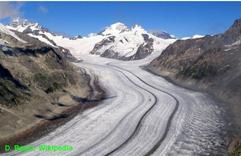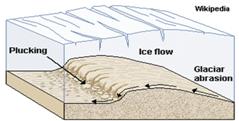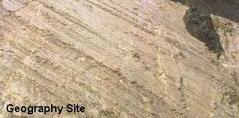By Ice

Aletsch glacier, Alps
See examples of glacial effects in Britain.
A glacier is a river of ice formed from compacted snow. They are most common in the Polar regions (e.g.Antarctica) and in mountain regions like the Alps and Himalayas. Glaciers move slowly down valleys (at speeds up to a few metres per day), but have enormous erosive power. Glaciers erode the surface of the Earth in two ways:
Plucking
 Melt water at the base of the glacier enters cracks in the bedrock and re-freezes, causing the rock to break apart (see also Weathering pages)
Melt water at the base of the glacier enters cracks in the bedrock and re-freezes, causing the rock to break apart (see also Weathering pages)As the glacier continues to move the broken rock gets stuck in the ice and carried away.
Abrasion

Rock surface scratched by glacial abrasion.
As the glacier moves downhill, rock fragments embedded in the ice at the base of the glacier scrape and grind against rock beneath the ice.Glaciers erode rapidly downward, forming deep, U-shaped valleys.

